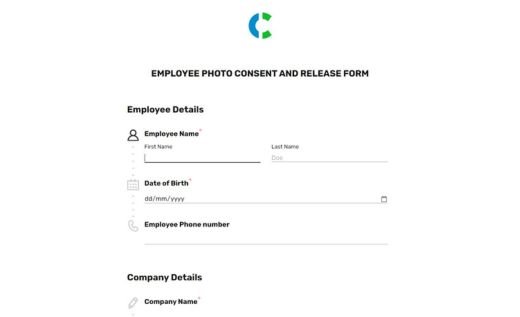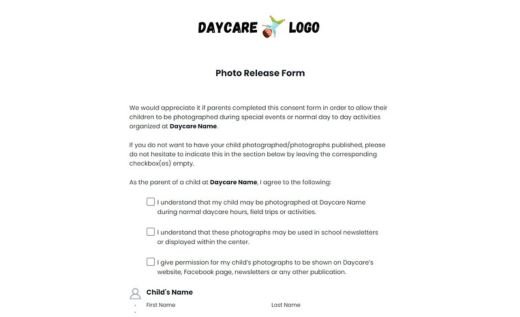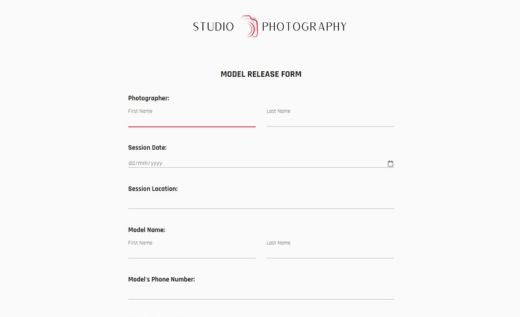Video Release Form Template
If you’re filming or asking someone to be in a video, having a video consent form is a must. It’s a simple way to get clear permission for personal or commercial use while protecting you from copyright and other legal issues.
With AidaForm, making permission forms is quick and stress-free. Its easy-to-use design tools and prebuilt templates for filming people and events let you start right away and adjust every detail to match your needs.
Check out the sample below — it’s a generic example you can customize to your situation (and consider a legal review if needed). Whether it’s for videotaping a project or capturing special moments, you can save filled forms as a PDF for easy access and even get secure signatures with a stylus or gesture.
Videography Release Forms: Real-Life Uses and Quick Templates
Let’s look at some common situations where getting someone’s permission for video recording is important — and the right form to use for each case.
Recording Minors
When children are featured, a video release form for minors or parental consent form helps you stay compliant with the law, protect the child’s rights and explain clearly how their footage will be used.
Monitoring Employees
If you’re using cameras in a work environment, an employee video surveillance consent form explains why you’re recording, what areas are covered and how the footage will be stored or shared. This addresses privacy concerns and keeps you in line with legal obligations.
Filming Models
For modeling projects, a model video release form outlines the agreement between the model and creator, covering rights, permissions and how the recorded content can be used commercially. It helps prevent misunderstandings later.
Capturing Weddings
At weddings, a consent form gives you permission to capture and share special moments while respecting the privacy of guests. It sets a clear agreement for using footage from the day.
Conducting Interviews
A filming interview permission form provides legal consent to capture a person’s likeness, voice and words in your final video. It explains exactly how the footage will be used and protects both interviewer and interviewee.
Producing a Music Video
When working on a music video, a release form confirms everyone’s permission to record and share the project. It outlines the rights of the crew, performers and producers and helps prevent disputes over creative or commercial use.
Filming on Campus
If you’re recording individuals at a school or university for commercial purposes, such as producing promotional materials for students, a consent form helps you stay legally compliant and clearly explains how the recordings will be used. It also addresses privacy concerns and protects both the institution and participants.
AidaForm’s basic template works for all these scenarios and many other times you need to share video footage. You can also browse the options below — just a few small edits will turn them into forms suited for all kinds of video projects.
FAQs about Video Release Forms
What Is a Video Release Form?
Sometimes referred to as a waiver, it’s a document that grants permission to feature someone’s image, voice or performance in a video. It spells out how that material can be used, helping protect both the person on camera and the person or team handling the video production. By setting clear rights, permissions and limits, it prevents misunderstandings and legal trouble.
When Do You Need a Release Form for Video?
You’ll need a release form whenever you plan to share videos with recognizable people for commercial or public purposes. This could be marketing campaigns, advertising, documentaries or any video content intended for the public. The form guarantees you have proper consent and protects both the production team and participants from legal issues.
What Needs to Be Included in a Video Consent Form?
A simple form of this kind should cover the basics so everyone is on the same page:
Participant information: Complete name, contact info and any important identification.
Project details: What the project is about, its scope and how the video will be used.
Rights granted: Which permissions are being given, such as use of image, voice or performance, plus any limits.
Duration: How long the consent lasts — one project only or ongoing.
Release conditions: When and how consent can be withdrawn.
Signatures and date: Both sides sign and date to confirm they agree.
If relevant, you can also include details about any payment or benefits the participant will receive.
Remember, the exact wording and requirements for a release form can vary depending on local laws and privacy rules, so double-check that yours complies with the legal standards in your area.
How to Edit a Standard Video Release Form with AidaForm
With AidaForm, it’s easy to take a free video release form and make it your own. Just follow these four quick steps:
1. Open the template.
Log in or create a free account , find the form sample and hit Use This Template.
2. Edit the content.
Add, remove or rearrange fields from the Form Elements panel. To include your logo, simply add a Media File block.
3. Add consent checkboxes.
Include checkboxes so participants can give clear, informed consent — a small step that boosts legal protection.
4. Make it yours.
Customize colors, icons, fonts and layout through the Form Designer panel.
Bring legal clarity and confidence to your projects — AidaForm’s versatile template ensures a smooth and secure process, protecting the rights of everyone involved.


